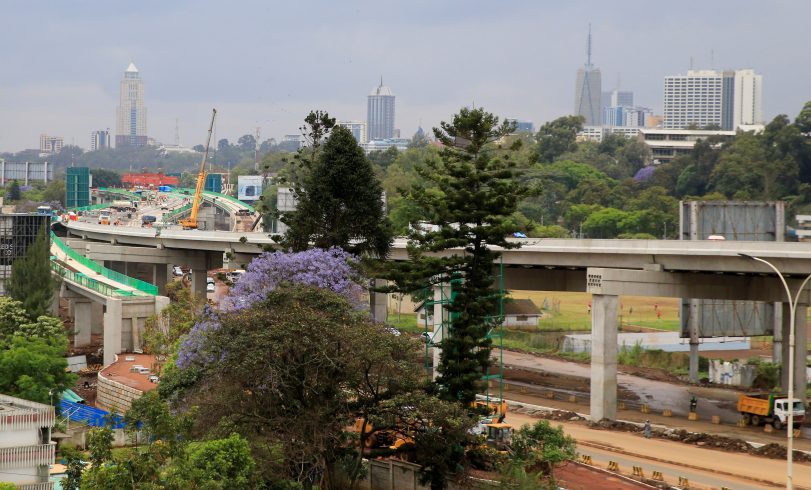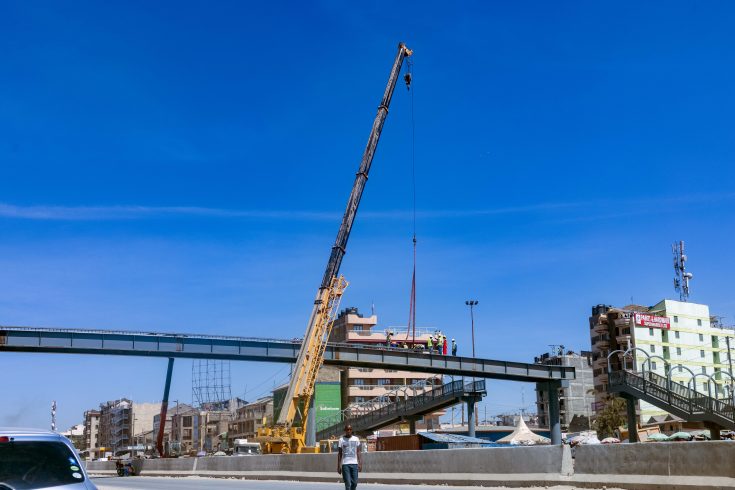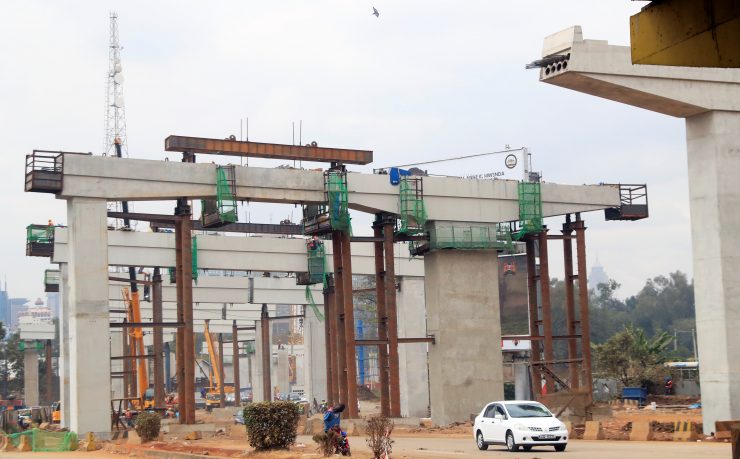When the Maasai – who seemed to have named everything in this town – pronounced ‘Enkare Nairobi’ (meaning a place of cool waters, which Nairobi was apparently known for), they mustn’t have imagined that a time would come when the place whose plains they once traversed with great abandon would be a long way from cool, dotted by hotheads and an expansive skyline, its urban planning cracks filled by a deluge of often times half-arse high-rise buildings.
Today, Nairobi is in a hurry. A hurry to grow up (or is it to chill with the big boys as Amapiano enthusiasts would say?). A hurry to finish its mega construction projects, a city under the constant weight of a hammer; moving things here, moving things there, changing this, sky-lifting that. Always building something, somewhere, sometime, somehow; the greenery going… gone!
The area Nairobi currently occupies was essentially an uninhabited swamp until a supply depot of the Uganda Railway was built by the British in 1899, linking Mombasa to Uganda. Chosen due to its centrality between Mombasa and Kampala – and its network of rivers and high-altitude elevation – it was the perfect place to house not only the British settlers, but also thousands of Indian laborers who came to Kenya seeking to be employed to work on the railway line. With such a flattering location, Nairobi grew big enough to become the railway’s headquarters. From then on, Nairobi, like a hooting train on a windy rail, has never taken a day off.
To Be Nairobi Is To Be Restless
It is a sort of code of conduct, one of those things that is deeply ingrained in every Nairobian, where we just don’t know how to take things slow. People are always in motion, except when they’re not. Staring and grinding, looking for opportunities, but before finding them needing to know someone, or be known by someone because this a city that is built on the sweat and bone of the common man, the blood and pain of journeymen—that’s the language of the worker—a nervy construction site, like a Tower of Babel but for buildings and roads and malls and railway lines and bridges and houses and more houses and more plastic-looking apartment blocks.
For decades, Nairobi’s a-dollar-a-day labourers have ensured things work, somehow, steadying the ship even when we’ve sailed close to the wind. Everyone is doing something in Nairobi, where you are greeted with one-word replies, and if you dig too deep, people grow suspicious and shun you. It’s a city defined by sweating the asset, polishing the cracks and letting parts of the town grow thin.
“Naenda hustle,” they say. That is enough information, that is all the information. Depending on which side of the divide you are, and whom you ask, Nairobi either embraces or eschews you. The music blares. 50 Cent. Trio Mio. Bow Wow Yippy Yoh Yippy Yeh. Construction workers plug in their headphones as contractors bellow instructions. “Wapi kokoto?” “Ongeza simiti!”
This Is How We Nduthis
I long ago gave up the ghost with matatus and Ubers, and converted to the religion of nduthis (nee bodaboda) to navigate the mjengo site that is Nairobi. I started using nduthis when the now defunct Safeboda, a ride-hailing app, landed in Kenya. That was in late 2018. Safeboda brought structure to an otherwise chaotic industry, making the commute shorter—trust a boda guy to know all the nooks and crannies of the city.
But even then, my boda guy, El-Derrick Msanii, could not have predicted the mutation and consequent exponential growth of nduthiverse. In a country grappling with severe unemployment, the youth have quickly grown the business into a multibillion industry. This permeation means I am home and dry; I can use a nduthi whenever, wherever. But then nduthiverse couldn’t escape Nairobi’s pitfalls.
Without adequate self regulation and bylaws requiring helmets or licences, nduthis have sadly acquired nuisance value, with those on nduthiverse’s rough edges causing accidents and either vamoosing without consequence or signaling their comrades to manhandle whoever they’ve hit or has hit them on the road, a gangland of sorts. Then there’s the helmet hel-hazard. For a time, I didn’t wear a helmet, thanks in part to the Coronavirus pandemic and the fact that most helmets are dirty anyway. It got easier to buy one’s own helmet, and that’s what I recently did.
As we negotiate the corners and gaping potholes caused by excavators, moving through Nairobi by nduthi becomes an out of body experience. As the city rises and falls, as the buildings move and stand still, the gritting mallets and drilling cranes get louder and louder, you have not finished one site than run into another. And there’s a sense that if you dare to reach out with your hand, you will touch something that is the essence of Nairobi: risk and weakness, pain and pleasure. As you move in the city, it also moves with and beside you.
Naenda Hivi Nacome
I live along Ngong Road, and make my way through Valley Road and into the Central Business District. As I approach the almost-complete in-your-face Nairobi Expressway at the Uhuru Highway and Kenyatta Avenue Junction (I’m just realizing both roads cutting the junction have the President’s name), the dust rises and falls, and the coughing, incessant and choking, reaches for my throat, grabbing and squeezing it.
The foremen’s instructions, the drilling trucks, the blaring machetes all reflect a city under a hurry, getting ready to go somewhere, do something. Hidden behind these construction dens are more estates, where flats are becoming more common than apartments, and space is a luxury. People are crammed into tiny spaces, and just when you think it’s done, more people are packed into it.

It’s a hound dog for satiating the appetite of hungry investors. These investors have sprawled Nairobi, sharply separating it into two: Eastlands, the workers for the West, public schools and budget living. Westlands; high end, address-living and private cars, international NGOs and leafy suburbs. The kings and the king-makers. Either you are a have or a have not. There is no-between.
Realtors are smiling all the way to the bank as buildings near completion and their prices skyrocket into the stratosphere, the sprawling road network notwithstanding. Everyone is getting excited, there is a sense of optimism in the air, giving the feeling that Nairobi is getting ready to go somewhere important. Somewhere cool. Enkare Nairobi.
Enter the Red-Plated Expat
A lot of foreigners want to come to Nairobi, what with glowing praises generously laid out in spreads of the Financial Times by wowed mzungu journos – it’s no longer just about the dusty safari. Now there’s more – exclusive dining spots, giraffe feeding breakfasts, Karen homes turned into boutique hotels where Kojo Annan and his ilk hold court. Then there’s the race for international NGOs moving their headquarters to the city under the sun – it’s no longer just about the only other UN office outside of New York. Your Oxfams, too, have set up shop.
It all makes sense. Go where the money is being spent – especially your home currency, the Yuan, the Yen, the Dollar. With a glossy portfolio – the Chinese are building the tallest building in the country, Nairobi has morphed from the city with a national park into one large glittering shopping mall. Anything and everything can be found here, and what is not, well, do you have some time while we build it quickly? Karibu Kanairo.
As I hail my nduthi guy, I realise that maybe this is what life will always be like, the now infamous new normal. What Nairobi will always look like and feel like, never static, always banging. That there will always be an ongoing project; a road, an apartment block, a commercial skyscraper, because wherever you look in Nairobi, a Men At Work sign stares back at you. This is Nairobi’s amor fati, watch your step, mind your head and good luck not falling in a ditch.
What’s the Economic Effect of All This Construction?
As money flows into the capital, Nairobi has had to keep pace with the infrastructure, housing and general urban living demands of an increasingly middle-class-ish and global city. To some extent, the city has been a victim of its own success. As the concrete sprawled, masses flocked to the city in search of jobs. Kenya is urbanising at a rate of 4.3% per annum, almost twice the global average of 2%.
The danger, if the government cannot keep up with all the private development, is a vicious cycle of disconnected and unplanned developments which does not provide the benefits required to businesses or residents. This is evidenced by either abandoned or unoccupied buildings in major residential areas like Kibera, Kawangware, and even Upper Hill. Nairobi’s construction success is creating problems as it solves them. A vicious cycle of growth.

Nairobi is notorious for its perennial traffic jams, which are estimated to cost the economy upwards of KSh 60 billion a day. Nairobi’s major highways, Mombasa Road and Waiyaki Way, not only cut the capital into two equal geographical sections but also serve as the main transport artery for the country, linking Mombasa to western Kenya neighbouring countries. In August 2021, commuters were stranded overnight in a grizzly traffic jam on Mombasa Road, as heavy rains and lack of way leaves conspired to keep them on the road.
Disruption on these two main highways thus causes a chain link reaction on the three main arteries that bring or evacuate traffic from Nairobi — Thika Superhighway, Lang’ata and Jogoo roads. Worthy to note is that Kenya is the third biggest economy in sub-Saharan Africa after Nigeria and South Africa, and thus what happens in Nairobi has a regional ripple effect.
The city’s top layer is a fusion of new buildings rising above established landmarks, like a younger sibling suddenly growing taller than their elders and wanting to gloat over their new dominance. You wake up today and find a new building. If you leave Nairobi and come back in a month, you will probably find a new tower looking down intimidatingly at you.
Is that a good thing?
Well, history shows that we are outperforming ourselves and may fall into the unsustainability trap. What used to take two hours to Utawala, now takes three or four. That contributed to my abandoning of Utawala and moving to the further developed Ngong Road with its many traffic stops. The Nairobi metropolitan region, especially, almost grinds to a halt during rush hours. Roads that were previously considered a godsend such as Thika road, and some of the bypasses, have become a nightmare for motorists, while the ones notorious for traffic have turned into ‘parking’ lots.
The capital city is a ringstrasse of dust and cranes. Everywhere you turn, there is either a road under construction or a pavement being done. But there is more than meets the eye, because, due to a combination of poor planning and/or management, Nairobi lacks adequate space for way leaves.
What Are Some of the Sites Within the Mega-Site?
According to Construction Site, an archive that focuses on projects valued at Sh10 billion or more that are either underway or recently announced, there are currently a myriad high-level projects under construction. Kenya, under President Uhuru Kenyatta, has heavily invested in infrastructural development, especially in the transport sector.
- The Nairobi Expressway

The magic wand that is poised to solve Nairobi’s traffic congestion, the Ksh 62 billion Nairobi Expressway is a 27.1km road project starting at Mlolongo in Machakos County, cutting through Nairobi past the Jomo Kenyatta International Airport (JKIA), elevated above downtown Nairobi and culminating in Rironi, Kiambu County.
Its bragging rights? A 15km bridge, with 10 interchanges, 15 entry and 14 exit ramps, 8 footbridges, 4 underpasses, 2 pedestrian underpasses, 27 toll stations and 27km of elevated and ground level lanes. The road is touted to have provided employment to over 4,000 workers with an array of heavy machinery under its bottom: 63 excavators, 10 drilling machines and 40 crates, to mitigate the effects of losing over 1 billion dollars annually in traffic snarl ups, coming complete with a four-lane and six-lane dual carriageway within the existing median of Mombasa Road, Uhuru Highway, and Waiyaki Way as well as 10 interchanges.
The section between the Eastern and Southern bypasses will be a six-lane dual carriageway while the section from to the Eastern Bypass and that from the Southern Bypass to James Gichuru will be a four-lane dual carriageway. Travel time from Rironi to JKIA is expected to slash to just 20 minutes from the initial, wait for it, three hours.
It is the first expressway built in East and Central Africa and the second largest toll road in Africa after the Dakar Toll Highway. The highway, which is being built by China Road and Bridge Corporation (CRBC), on a public-private partnership (PPP) basis, has a concession period of 30 years – including three years of construction.
- The GTC Building
The Ksh 40 Billion Global Trade Centre project is an ultra-premium HOPSCA (hotel, office, parking, shopping mall, convention, and apartment) in Nairobi which boasts East Africa’s tallest office tower, a 35-level hotel tower that will host the star-studded luxury five-star JW Marriot Hotel, 4 residential & serviced apartment towers 24 to 28 levels & a luxury boutique mall.
The topping out of the Nairobi GTC Office Tower, the 184-metre, 43-storey office block is expected to be the Africa headquarter for Chinese firm Avic, which is seeking to set up its continental hub on a 7.5-acre piece of land in Westlands, Nairobi. The ‘I love Nairobi’ logo is printed on the high-rise windows of the GTC office tower to celebrate the cultural diversity and vibrancy of the city as well as communicate optimism to Nairobi residents and tourists, just for good measure.
- The Pinnacle Hilton
Though currently on hold (inaugurated in May 2017), the project comprises a 5-star hotel and a 300 metres high office block that will overtake Leonardo in Sandton, South Africa, as Africa’s tallest building.
The 255-room Hilton Nairobi Upper Hill will be hosted on the 45-storey wing, while the 70-storey wing will comprise Grade A commercial offices and a luxury shopping mall.
- Nairobi Railway City
Recently, the government released a master plan for the proposed Nairobi Railway City, that involves construction of a 425-acre urban development on the area between Haile Selassie Avenue, Uhuru Highway and Bunyala Road – comprising transit stations, residential and commercial buildings et. cetera
- Nairobi Western Bypass
Construction is underway on the Nairobi Western Bypass, a Sh17 billion 16.79 km highway that seeks to ease traffic congestion in the city by China Road and Bridge Corporation.
